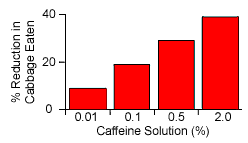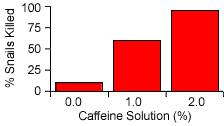 | Caffeine
Used to Fight Slugs and Snails |
 | Caffeine
Used to Fight Slugs and Snails |
 July 25, 2002
July 25, 2002In October 2001, the US Environmental Protection Agency (EPA) announced that it had approved the use of caffeine to fight the infestation of Hawaiian coqui frogs. New research suggests that caffeine may be a weapon against other pests such as slugs and snails. As most gardeners know, slugs and snails cause significant damage to vegetable crops. However, many products used to eliminate slugs and snails contain chemicals that are dangerous to people and pets. Caffeine-containing products, therefore, may be a safe alternative to existing slug and snail poisons. Researchers at the US Pacific Basin Agricultural Research Center and National Wildlife Research Center in Hilo, Hawaii, conducted several experiments to demonstrate the effectiveness of caffeine to repel and kill slugs and snails. | |
Experiment #1 - Will slugs avoid food with caffeine?Napa cabbage leaves were dipped in caffeine solutions or left untreated (the control condition). The researchers measured how much cabbage was eaten by the slugs.Results: Slugs did not eat as much cabbage when the leaves were dipped in caffeine (see Figure 1). This suggests that slugs can detect the caffeine and prefer cabbage without caffeine. |
Figure 1 |
 Orchid Snails Photo by Scott Bauer, USDA |
Experiment #2 - How does caffeine affect the heart rate of snails?Orchid snails (Zonitoides arboreus) were treated with caffeine. The researchers examined changes in the heart rate of the snails.Results: After one hour, weak (0.01%) caffeine solutions increased the snail's heart rate, but stronger solutions (0.1%, 0.5% and 2%) reduced the snail's heart rate. After 24 hours, the heart contractions of snails treated with a 0.1% or higher concentration of caffeine were weak and irregular. After 96 hours, all of the snails treated with a 0.5% or 2% caffeine solution were dead. |
Experiment #3 - Will caffeine kill snails when applied to material used to grow plants?Chips from coconut husks are used to grow orchids. These chips were sprayed with 1% or 2% caffeine solutions or with water (the control condition).Results: The 1% caffeine solution killed 60% of the snails. The 2% caffeine solution killed 95% of the snails. Only 10% of the snails died when the control solution was used. (See Figure 2) |
Figure 2 |
The researchers are not sure how caffeine kills slugs
and snails. They suggest that caffeine may change the shape of action potentials in snail neurons. In humans, caffeine is a central nervous system stimulant that
interferes with adenosine, a neurotransmitter
in the brain. Caffeine also acts at other places in the body to increase
heart rate, constrict blood vessels, relax air passages, and affect
muscles. 
Perhaps new, safer slug and snail repellents could be developed with caffeine. Who knows? Perhaps next time you buy a cup of coffee, you will also be able to pick up some slug and snail bait for your garden.
| |
References:
|
| GO TO: | Neuroscience In The News | Explore the Nervous System | Table of Contents |
![[email]](./gif/menue.gif) Send E-mail |
 Get Newsletter |
 Search Pages |